Discover the complete Freesia care guide, from planting bulbs to nurturing blooms. Learn essential tips for soil preparation, watering, sunlight requirements, and more to ensure vibrant and fragrant flowers in your garden.
Do you love the sweet, intoxicating fragrance of freesia flowers? These funnel-shaped blooms come in a rainbow of colors and perfume the air with their rich, fruity aroma. While native to South Africa, these beauties are easy to grow as houseplants or in outdoor gardens.
In this freesia care guide, you’ll learn everything you need for successful planting, growth and prolific flowering from these showy bulbs. With a few simple tips, you can enjoy an abundance of long-lasting freesia blooms!
What are Freesias?

Sure! Here’s an easy-to-read and verified information chart for Freesias:
| Feature | Details |
|---|---|
| Botanical Name | Freesia spp. |
| Common Name | Freesia |
| Plant Type | Perennial (grown as an annual in colder climates) |
| USDA Hardiness Zone | 9-10 (can be grown in other zones with proper care) |
| Sun Exposure | Full sun to partial shade |
| Soil Type | Well-draining, sandy or loamy soil |
| Watering | Regular during growing season; reduce during dormancy |
| Growth Habit | Upright, clump-forming |
| Height/Spread | 12-24 inches tall / 3-4 inches apart |
| Special Features | Fragrant blooms, vibrant colors, attracts pollinators |
Freesias are herbaceous perennial plants that grow from small corms or bulbs. Part of the Iridaceae family related to irises, there are around 16 different freesia species, with Freesia x hybrid being the most common.
These plants produce slender, upright stems topped with clusters of narrow, tubular flowers. The blossoms have six tepals (three petals and three sepals) that fan outwards, with a funnel shape similar to daffodils.
While they originated in South Africa, most freesia varieties today are hybrids developed in the Netherlands. Breeders have created countless vivid colors including white, yellow, orange, red, pink, lavender and bicolors.
Benefits of Growing Freesias
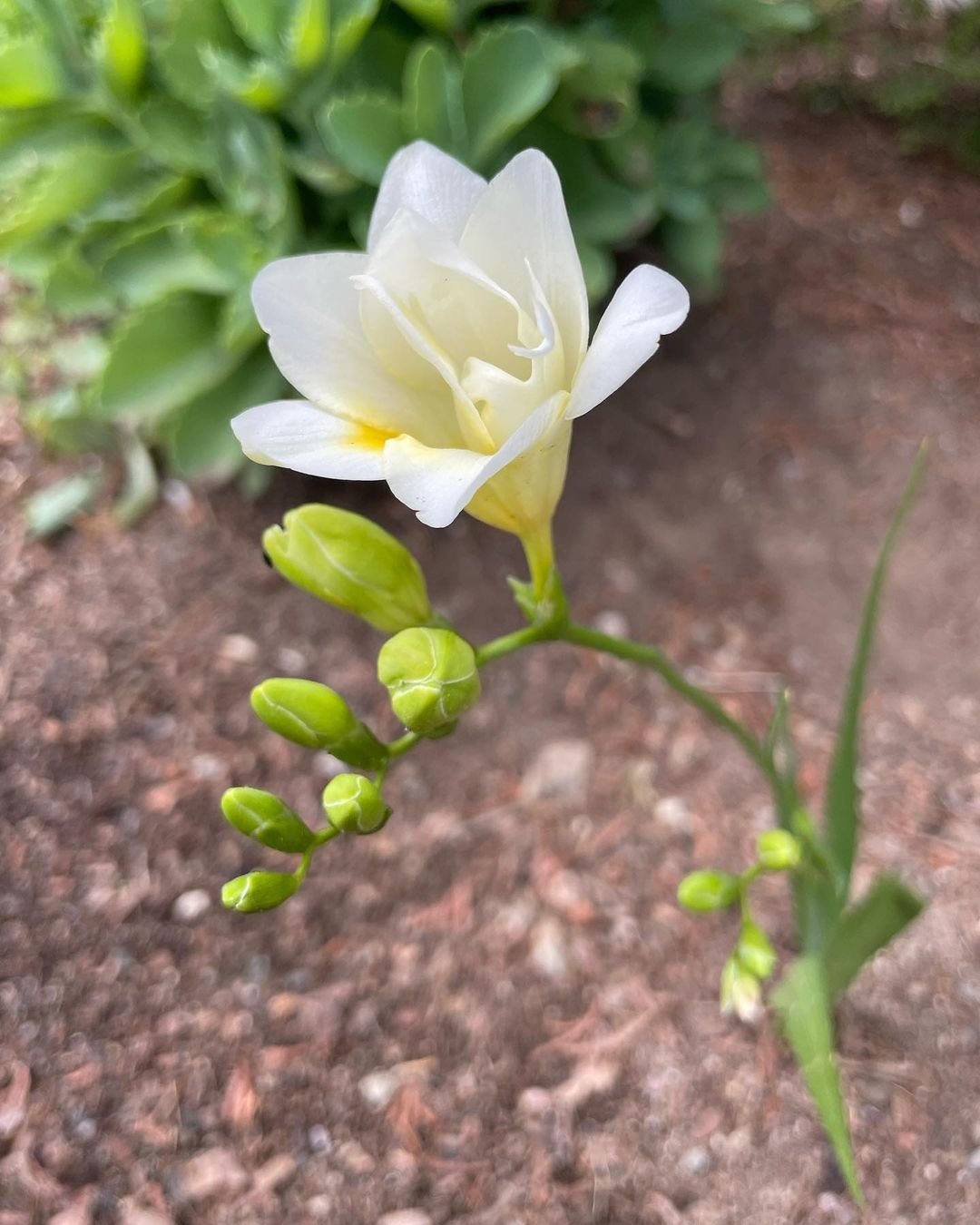
Aside from their incredible fragrance and vibrant color varieties, freesias offer many other benefits for gardeners:
- Long Vase Life – Cut freesia stems can last 7-14 days in a vase, providing long-lasting flowers.
- Winter/Spring Blooms – These chilly season bloomers add color when little else is flowering outdoors.
- Low Maintenance – Freesia corms are easy to grow and require little care once planted.
- Deer Resistant – The bulbs contain toxic compounds that deter deer and rodents.
- Fragrance – That heavenly sweet scent instantly uplifts moods and freshens indoor spaces!
With their elegant flowers and intoxicating fragrance, it’s easy to see why freesias have grown so popular worldwide. Add some spring charm to your home or garden by growing these low-fuss flowering bulbs!
How to Plant Freesia Corms

To get started with freesias, you’ll need to purchase fresh, plump corms. Small and flat corms often don’t produce great blooms. Look for the largest, firmest corms you can find.
In mild climates, freesia corms can be planted directly outdoors in late summer or early fall, around 12 weeks before your winter arrives. In cold regions, they must be grown as indoor potted plants.
For outdoor planting, choose a sunny spot with well-draining soil. Add compost or fertilizer to enrich the soil first. Space the corms 2-4 inches apart and 2-3 inches deep, with the flat or rounded side facing down.
Cover with soil and water thoroughly to settle the corms. Top with a 2-inch mulch layer to retain soil moisture.
For indoor pots, use a lightweight potting mix in a 6-8 inch container with drainage holes. Position the corms pointed side up 2 inches apart and 2 inches deep. Water and keep in a sunny room around 60-70°F.
Light & Temperature Needs

Freesias require at least 6 hours of direct sunlight per day, with morning sun being ideal. Too much shade results in weak, floppy stems and fewer blooms. Grow lights can supplement natural light indoors if needed.
However, intense heat and midday sun tends to make blossoms fade faster. Try to provide some afternoon shade from the hottest direct rays.
These South African natives also prefer cooler temperatures between 60-70°F during spring bloom time. Hotter temps above 75°F cause plants to yellow and decline faster after flowering.
If growing indoors, move potted freesias into a cooler room or shaded patio once blooms emerge. Cooler nights help extend their colorful display.
Watering Freesia Plants

Maintaining the right moisture level is critical for healthy freesia growth and flowering. The soil should be allowed to dry out slightly between waterings but never become bone dry.
For planted corms and bulbs, water well once you see 1-2 inches of new foliage growth emerge. Then, keep the soil consistently moist but not soggy. Too much or too little water causes corms to rot.
Container plants need more regular watering, about once the top inch of soil begins to dry out. Always water thoroughly until moisture drains from the bottom.
Signs of overwatering include wilting foliage, yellow leaves and stunted growth. Let plants dry out more before the next round of watering if this occurs.
Feeding Requirements
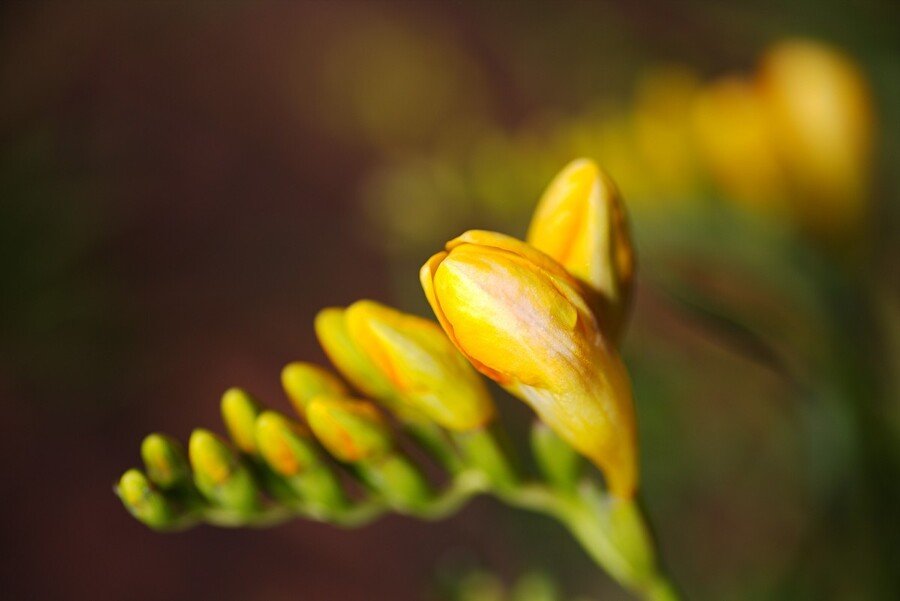
Providing the right nutrients gives freesias the energy for lush growth and maximum flowering. However, too much fertilizer can actually prevent or deform blooms.
For outdoor plantings in garden beds, top dress with a balanced 10-10-10 granular fertilizer as soon as foliage emerges in early spring. Avoid getting fertilizer directly on corms.
Potted freesias need a liquid houseplant fertilizer once every 3-4 weeks after sprouting. Look for a balanced 20-20-20 ratio at half-strength. Too much nitrogen creates lush leaves but reduces blooms.
Also incorporate some compost, worm castings, or manure into the soil when planting to provide slow-release nutrients.
Ideal Pruning & Grooming
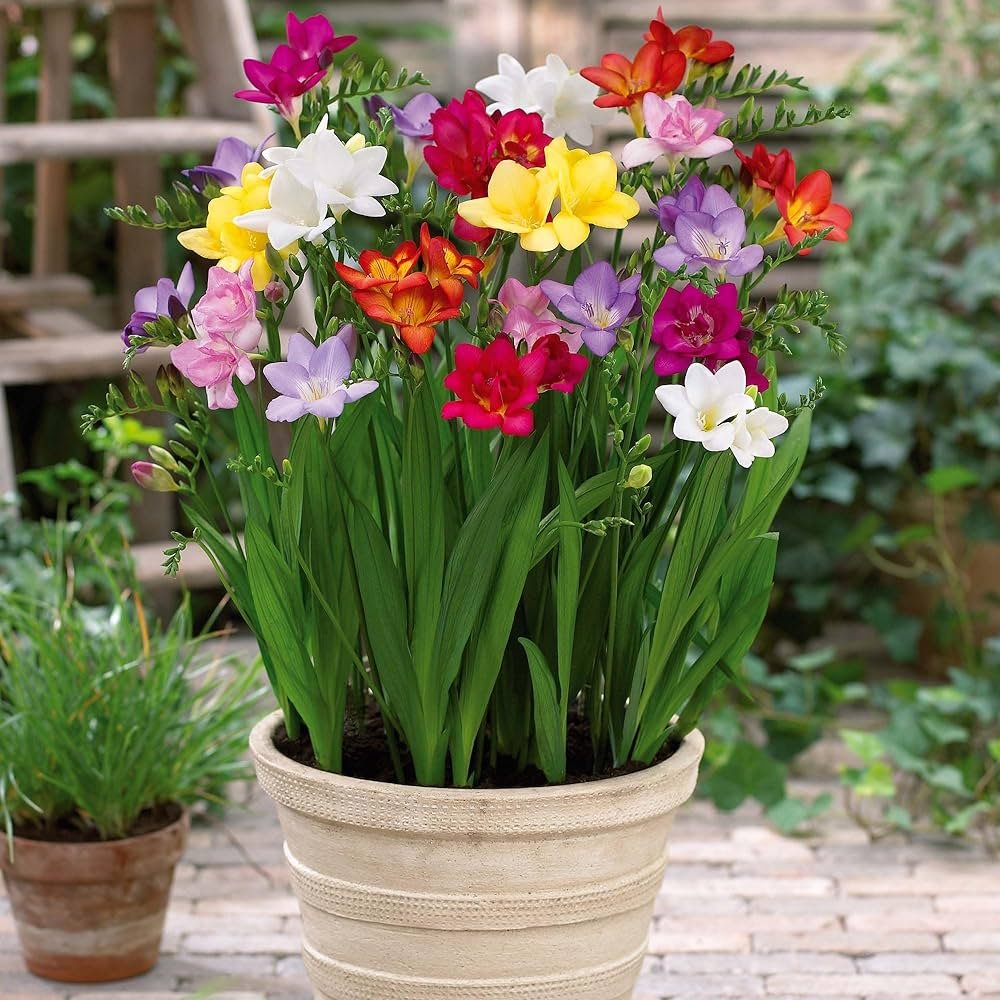
To keep freesias looking tidy with more energy devoted to flowering, some minor pruning and grooming is recommended:
- Remove spent flower stems all the way to the ground as they fade.
- Cut off dead, damaged, or yellowed foliage whenever it appears.
- Shear off the entire flower stalk once blooming finishes for the season.
- Deadhead individual flowers if you don’t plan on letting seeds develop.
For indoor plants, stop pruning once all foliage has yellowed and died back in late spring. This allows the corms to store energy for next year’s growth cycle.
Staking for Support
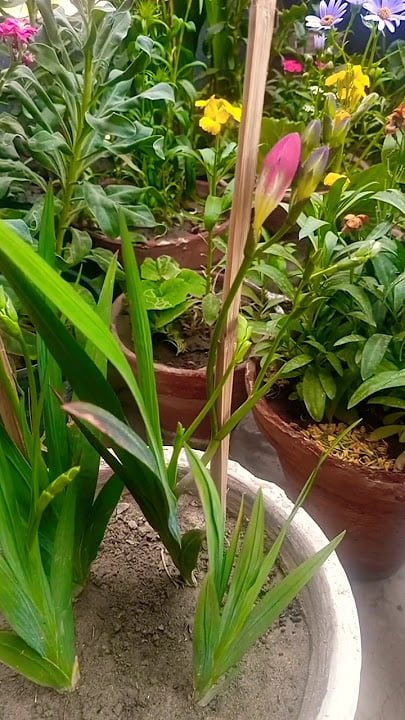
Freesias grow slender, delicate stems up to 18 inches tall that tend to lean or flop under heavy bloom clusters. To prevent this, consider staking your plants using one of these methods:
- Bamboo stakes – Insert three or more bamboo canes into the soil around the stems and loosely tie them together at the top.
- Plastic mesh grid – Position a square mesh grid over the foliage to provide a sturdy support network for flowers.
- Peony rings – These sturdy circular wire rings are placed around the base to contain stems as they grow upwards.
Staking helps display the blooms nicely and prevents damage or breaking from heavy winds or poor weather. For containers, staking is highly recommended to avoid tipping or leaning.
Potential Pests & Diseases
While freesias are fairly resilient plants, they can be susceptible to some common threats every gardener should watch for:
Pests:
- Thrips – Suck sap from leaves, creating silvery streaks and distortion.
- Aphids – Found in clusters under leaves, aphids cause yellowing and distorted growth.
- Spider mites – Hot, dry conditions promote these pests that leave behind tiny webbing.
Diseases:
- Fungal diseases like botrytis – Appears as fuzzy gray mold on leaves and flowers.
- Bulb/Corm rots – Caused by over-watering and poor drainage, leading to mushy, foul-smelling bulbs.
The best defense is maintaining proper watering, spacing plants for good air circulation and quickly removing any diseased foliage. Neem oil, insecticidal soaps and fungicides can help manage severe pest or disease issues.
Dividing & Storing Freesia Corms
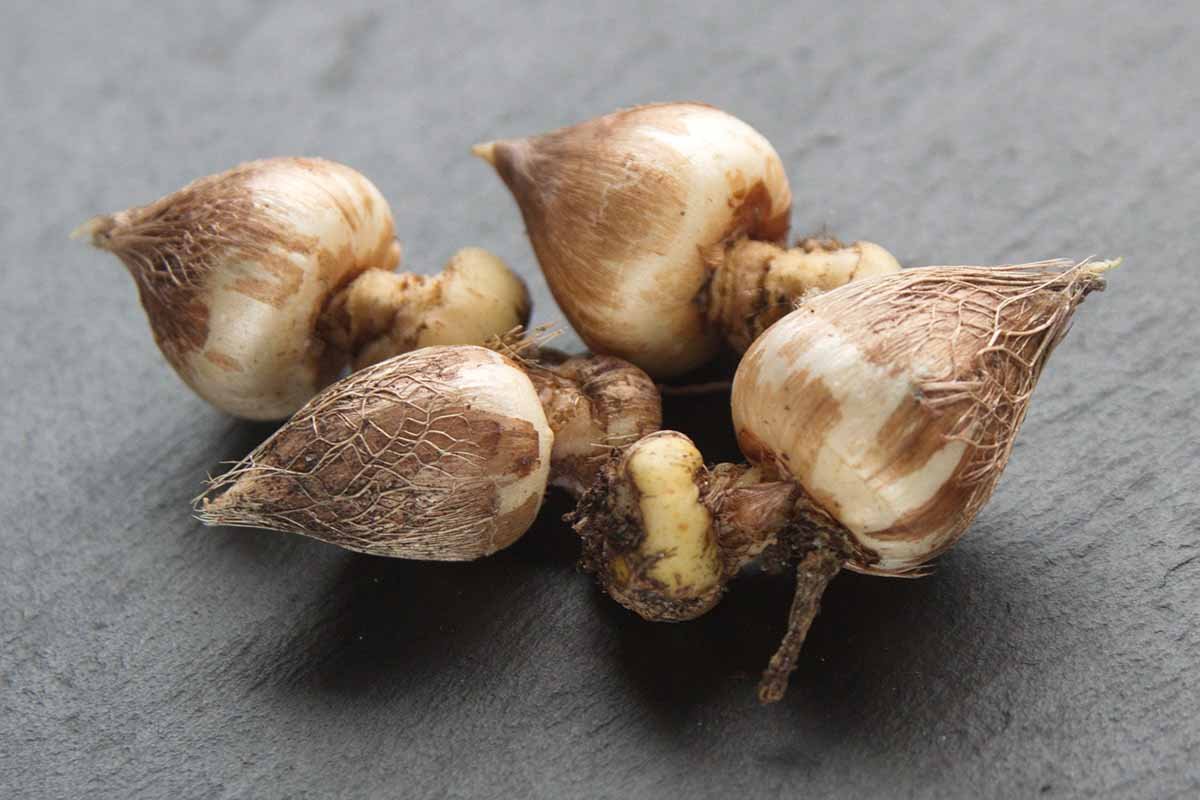
After 3-4 years, freesia corms become overcrowded and stop blooming profusely. This signals it’s time to dig up and divide the corms for replanting.
Wait until foliage has completely died back in late spring or early summer. Carefully dig up the corms, gently brushing off any soil.
Use a sharp knife to break apart the larger, thicker parent corms from the smaller baby corms. Discard any shriveled, damaged, or rotting corms.
The larger corms can be replanted right away at the same depth. The smaller corms should be stored for replanting in the fall.
To store freesia corms, first allow them to cure in a warm, dry location for 1-2 weeks until any remaining stems detach easily. Then place the corms in a mesh bag or container filled with dry peat moss, sawdust, or sand.
Keep stored corms around 60-65°F in a dim area until it’s time to replant in late summer or early fall. This resting period allows corms to recharge for the next growing cycle.
Freesia as Cut Flowers
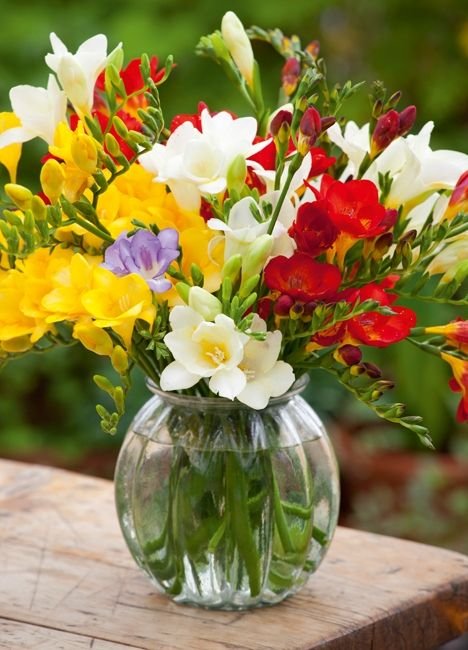
One of the best uses for freesias is as long-lasting cut flowers to brighten up indoor vases and bouquets! Their slender stems and clustered blooms make for gorgeous, sweetly-scented arrangements.
For maximum vase life of 7-14 days, cut stems in the morning after flowers have opened. Use a sharp knife or pruners to sever the stems around 6 inches from the ground at an angle.
Immediately place stems into clean water treated with a floral preservative. Remove any foliage that would be submerged to prevent bacteria buildup. Display in a cool, shaded location for longest-lasting blooms.
You can also let freesia stems develop seedpods for decorative dried arrangements! The papery, lantern-shaped pods persist for months before self-sowing seeds.
Freesia Variety Highlights
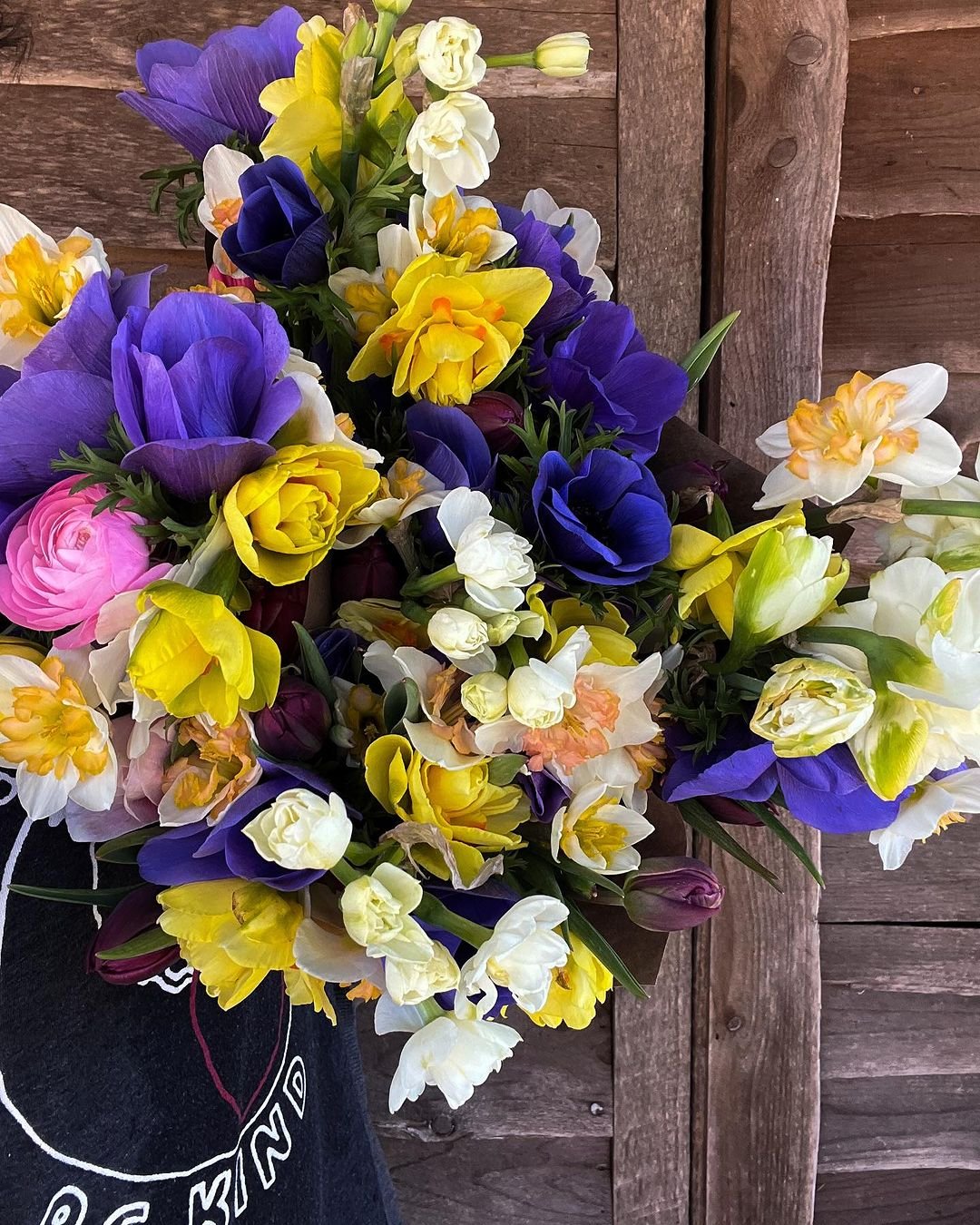
With so many vivid color options available, it’s tough to choose a favorite freesia variety! Here are a few top picks to consider:
- Aurora Sunray – Cheerful yellow petals with orange highlights.
- Avalanche – Bright, clean white flower clusters.
- Blue Heaven – One of the only true blue-purple freesia varieties.
- Carnival – Gorgeous bicolor blooms in shades of red, yellow and orange.
- Creme Brulee – Rich buttery-yellow blooms.
- Red Rover – Vibrant ruby red petals with a sweet fruity scent.
There are also many freesia blends available, providing an array of mixed colors in one package for beautifully varied bouquets.
No matter which hues you choose, these unique, low-maintenance flowering bulbs are sure to delight with their beauty and intoxicating perfume from winter into spring! With just a little care, you can enjoy an abundance of blooms.
By following this freesia care guide covering planting, lighting, watering, fertilizing, and more, you’ll be well on your way to successful growth and prolific flowering. Let their heavenly scent and rainbow of colors brighten up your home or garden!
Pingback: Explore 20 Fascinating Flowers Beginning with F - Gardener's School
Pingback: The Beauty of Hoya Plants : Care and Maintenance Tips
Pingback: Cultivating Iris Flowers : Tips for Stunning Blooms